Abstract
The existing theories of diffusion of gas-filled and empty bubbles in solids as yet do not have sufficient predictive power and require refinements that can be made using simulation. The method of the accelerated molecular dynamics simulation of the bubble drift in a pressure gradient is theoretically substantiated in this work. This method is used to calculate the diffusion coefficient of empty nanobubbles in aluminum. The theory of diffusion by means of the formation of critical terraces on the faces is supplemented in such a way that there is no contradiction with the continuous model for macroscopic dimensions. The simulation results show the key role of the formation mechanism of terraces in nanobubbles and confirm the amended theory. The inclusion of the effect of gas makes it possible to compare the simulation results with experimental data. The comparison also confirms the formation mechanism of terraces.
Similar content being viewed by others
References
Ya. E. Geguzin and M. A. Krivoglaz, Migration of Macroscopic Inclusions in Solids (Metallurgiya, Moscow, 1971; Consultants Bureau, New York, 1973).
P. Goodhew and S. Tyler, Proc. R. Soc. London, Ser. A 377, 151 (1981).
E. Y. Mikhlin and V. Chkuaseli, Phys. Status Solidi A 29, 331 (1975).
W. Beere and G. Reynolds, Acta Metall. 20, 845 (1972).
L. Willertz and P. Shewmon, Metall. Mater. Trans. B 1, 2217 (1970).
E. Y. Mikhlin, Phys. Status Solidi A 56, 763 (1979).
M. Veshchunov and V. Shestak, J. Nucl. Mater. 376, 174 (2008).
L. Noirot, J. Nucl. Mater. 447, 166 (2014).
M. E. Gulden, J. Nucl. Mater. 23, 30 (1967).
C. Baker, J. Nucl. Mater. 71, 117 (1977).
J. Evans and A. van Veen, J. Nucl. Mater. 168, 12 (1989).
R. Barnes and D. Mazey, Proc. R. Soc. London, Ser. A 275, 47 (1963).
K. Ono, S. Furuno, K. Hojou, T. Kino, K. Izui, O. Takaoka, N. Kubo, K. Mizuno, and K. Ito, J. Nucl. Mater. 191, 1269 (1992).
S. Tyler and P. Goodhew, J. Nucl. Mater. 92, 201 (1980).
É. Bévillon, R. Ducher, M. Barrachin, and R. Dubourg, J. Nucl. Mater. 434, 240 (2013).
G. Smirnov and V. Stegailov, J. Phys.: Condens. Matter 31, 235704 (2019).
A. Karavaev, V. Dremov, and G. Ionov, J. Nucl. Mater. 468, 46 (2016).
X.-Y. Liu and D. Andersson, J. Nucl. Mater. 462, 8 (2015).
B. Beeler, D. Andersson, M. W. Cooper, and Y. Zhang, J. Nucl. Mater. 523, 413 (2019).
D. Perez, L. Sandoval, S. Blondel, B. D. Wirth, B. P. Uberuaga, and A. F. Voter, Sci. Rep. 7, 2522 (2017).
N. Gao, L. Yang, F. Gao, R. J. Kurtz, D. West, and S. Zhang, J. Phys.: Condens. Matter 29, 145201 (2017).
K. Morishita and R. Sugano, Nucl. Instrum. Methods Phys. Res., Sect. B 255, 52 (2007).
D. Schwen and R. Averback, J. Nucl. Mater. 402, 116 (2010).
S. Hu, C. H. Henager, Jr., H. L. Heinisch, M. Stan, M. I. Baskes, and S. M. Valone, J. Nucl. Mater. 392, 292 (2009).
Y. Gao, Y. Zhang, D. Schwen, C. Jiang, C. Sun, and J. Gan, Materialia 1, 78 (2018).
L. Verma, L. Noirot, and P. Maugis, J. Nucl. Mater. 528, 151874 (2020).
A. Antropov, V. Ozrin, V. Stegailov, and V. Tarasov, J. Exp. Theor. Phys. 129, 103 (2019).
A. Antropov and V. Stegailov, J. Nucl. Mater., 152110 (2020).
M. Veshchunov, V. Ozrin, V. Shestak, V. Tarasov, R. Dubourg, and G. Nicaise, Nucl. Eng. Des. 236, 179 (2006).
M. Tonks, D. Andersson, R. Devanathan, R. Dubourg, A. El-Azab, M. Freyss, F. Iglesias, K. Kulacsy, G. Pastore, S. R. Phillpot, and M. Welland, J. Nucl. Mater. 504, 300 (2018).
W. Beere, Philos. Mag. 25, 189 (1972).
W. Beere, J. Nucl. Mater. 45, 91 (1972).
L. D. Landau and E. M. Lifshitz, Course of Theoretical Physics, Vol. 5: Statistical Physics (Nauka, Moscow, 1995; Pergamon, Oxford, 1980).
W. M. Brown, P. Wang, J. S. Plimpton, and A. N. Tharrington, Comput. Phys. Commun. 182, 898 (2011).
V. Stegailov, E. Dlinnova, T. Ismagilov, M. Khalilov, N. Kondratyuk, D. Makagon, A. Semenov, A. Simonov, G. Smirnov, and A. Timofeev, Int. J. High Perform. Comput. Appl. 33, 507 (2019).
M. Mendelev, M. Kramer, C. A. Becker, and M. Asta, Philos. Mag. 88, 1723 (2008).
R. Stumpf and M. Scheffler, Phys. Rev. B 53, 4958 (1996).
A. Antropov, V. Ozrin, G. Smirnov, V. Stegailov, and V. Tarasov, J. Phys.: Conf. Ser. 1133, 012029 (2018).
W. Jäger, R. Manzke, H. Trinkaus, G. Crecelius, R. Zeller, J. Fink, and H. Bay, J. Nucl. Mater. 111, 674 (1982).
Author information
Authors and Affiliations
Corresponding author
Additional information
Russian Text © The Author(s), 2020, published in Pis’ma v Zhurnal Eksperimental’noi i Teoreticheskoi Fiziki, 2020, Vol. 112, No. 5, pp. 325–331.
Funding
This work was supported by the Russian Foundation for Basic Research (project no. 18-08-01495).
Rights and permissions
About this article
Cite this article
Antropov, A.S. Diffusion of Nanobubbles in fcc Aluminum. Jetp Lett. 112, 310–315 (2020). https://doi.org/10.1134/S002136402017004X
Received:
Revised:
Accepted:
Published:
Issue Date:
DOI: https://doi.org/10.1134/S002136402017004X




